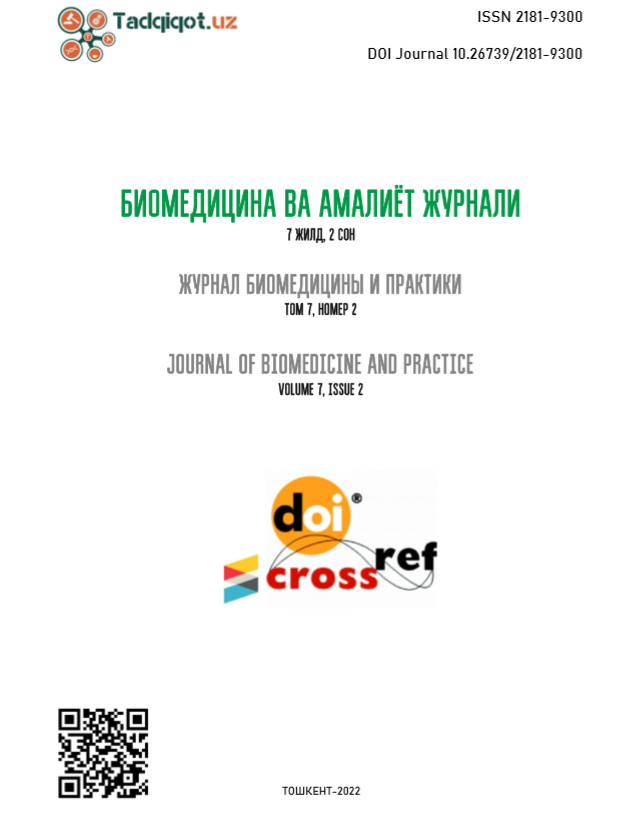STRUCTURAL AND FUNCTIONAL CHANGES IN THE LIVER IN THE EARLY REHABILITATION PERIOD OF COVID-19
Keywords:
coronavirus infection, SARS-CoV2, COVID-19, liver disordersAbstract
The purpose of the study: to assess the structural and functional state of the liver in patients in the early rehabilitation period of COVID-19.
Materials and research methods. Under observation were 243 patients who underwent COVID-19 at the age of 18-60 years. Inclusion criteria in the study were: transferred no earlier than 10 days prior to entry into the COVID-19 study; at the time of inclusion in the study PCR-negative COVID-19, negative PCR and markers of replication of hepatitis viruses. As a control group (CG), 20 healthy volunteers were examined. Serum enzymes were determined: alanine aminotransferase (ALT), aspartate aminotransferase (AST), gamma glutamyl aminotransferase (GGT), lactate dehydrogenase (LDH), alkaline phosphatase (AP), total and direct bilirubin, albumin. Ultrasound examination (ultrasound) of the abdominal cavity and liver elastometry.
Research results. The activity of blood enzymes in patients who underwent COVID-19 included in the study was significantly increased compared to CG: ALT exceeded the average values in CG by almost 10 times, AST = by almost 3 times, LDH by 3 times, GGT and ALP - almost one and a half times. The level of bilirubin in the CG was significantly higher than that registered in the CG (p<0.001). The concentration of albumin in the peripheral blood of patients was reduced (p<0.001, significant difference from CG). According to ultrasound, the CVR values of the right lobe and the diameter of the portal vein and splenic vein of the liver were significantly higher than in CG (p<0.01). When elastography was determined in most patients, F0 (52.67%) was recorded, less often - F1 (21.16%), F2 (14.81%) and F3 (5.35%).
Conclusion. In patients who have undergone COVID-19 in the early rehabilitation period, structural and functional changes in the hepatobiliary system are noted, characterized by cytolytic, cholestatic syndrome, a decrease in the protein-synthesizing function of the liver, as well as an increase in the size of the liver, the diameters of the portal and splenic veins, and an increase in the rigidity of the hepatic parenchyma.
References
Lau SKP, Chan JFW. Coronaviruses: emerging and re-emerging pathogens in humans and animals. Virol J. (2015) 12:209. 10.1186/s12985-015-0432-z
Epidemiological, clinical and virological characteristics of 74 cases of coronavirus-infected disease 2019 (COVID-19) with gastrointestinal symptoms. Gut. (2020) 69:1002–9. 10.1136/gutjnl-2020-320926 [PMC free article] [PubMed] [CrossRef] [Google Scholar]
Huang C, Wang Y, Li X, Ren L, Zhao J, Hu Y, et al. . Clinical features of patients infected with 2019 novel coronavirus in Wuhan, China. Lancet. (2020) 395:497–506. 10.1016/S0140-6736(20)30183-5 [PMC free article] [PubMed] [CrossRef] [Google Scholar]
Zhang Y, Zheng L, Liu L, Zhao M, Xiao J, Zhao Q. Liver impairment in COVID-19 patients: a retrospective analysis of 115 cases from a single centre in Wuhan city, China. Liver Int. (2020) 40:2095–103. 10.1111/liv.14455 [PubMed] [CrossRef] [Google Scholar]
Hao S-R, Zhang S-Y, Lian J-S, Jin X, Ye C-Y, Cai H, et al. . Liver enzyme elevation in coronavirus disease 2019. Am J Gastroenterol. (2020) 115:1075–83.
Hyder MA, Hasan M, Mohieldein AH. Comparative levels of ALT, AST, ALP and GGT in liver associated diseases. Eur J Exp Biol. (2013) 11:493–6. [Google Scholar]

